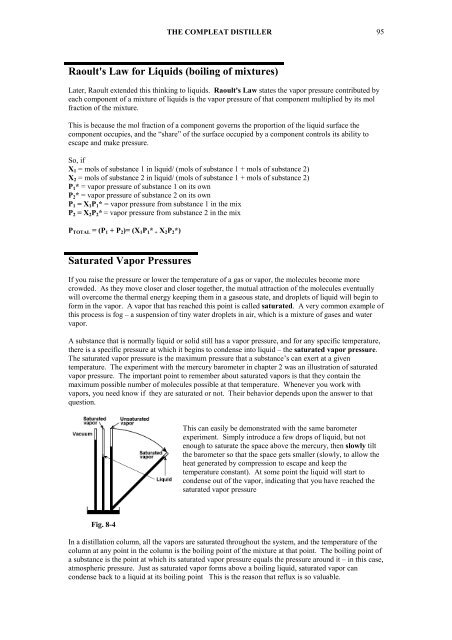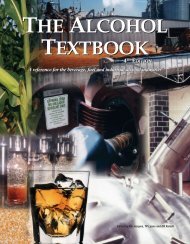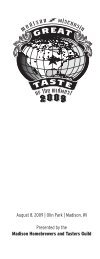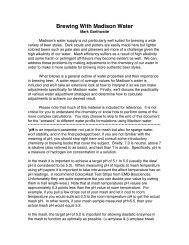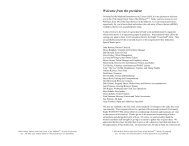The Compleat Distiller
The Compleat Distiller
The Compleat Distiller
You also want an ePaper? Increase the reach of your titles
YUMPU automatically turns print PDFs into web optimized ePapers that Google loves.
THE COMPLEAT DISTILLER 95<br />
Raoult's Law for Liquids (boiling of mixtures)<br />
Later, Raoult extended this thinking to liquids. Raoult's Law states the vapor pressure contributed by<br />
each component of a mixture of liquids is the vapor pressure of that component multiplied by its mol<br />
fraction of the mixture.<br />
This is because the mol fraction of a component governs the proportion of the liquid surface the<br />
component occupies, and the “share” of the surface occupied by a component controls its ability to<br />
escape and make pressure.<br />
So, if<br />
X 1 = mols of substance 1 in liquid/ (mols of substance 1 + mols of substance 2)<br />
X 2 = mols of substance 2 in liquid/ (mols of substance 1 + mols of substance 2)<br />
P 1 * = vapor pressure of substance 1 on its own<br />
P 2 * = vapor pressure of substance 2 on its own<br />
P 1 = X 1 P 1 * = vapor pressure from substance 1 in the mix<br />
P 2 = X 2 P 2 * = vapor pressure from substance 2 in the mix<br />
P TOTAL = (P 1 + P 2 )= (X 1 P 1 * + X 2 P 2 *)<br />
Saturated Vapor Pressures<br />
If you raise the pressure or lower the temperature of a gas or vapor, the molecules become more<br />
crowded. As they move closer and closer together, the mutual attraction of the molecules eventually<br />
will overcome the thermal energy keeping them in a gaseous state, and droplets of liquid will begin to<br />
form in the vapor. A vapor that has reached this point is called saturated. A very common example of<br />
this process is fog – a suspension of tiny water droplets in air, which is a mixture of gases and water<br />
vapor.<br />
A substance that is normally liquid or solid still has a vapor pressure, and for any specific temperature,<br />
there is a specific pressure at which it begins to condense into liquid – the saturated vapor pressure.<br />
<strong>The</strong> saturated vapor pressure is the maximum pressure that a substance’s can exert at a given<br />
temperature. <strong>The</strong> experiment with the mercury barometer in chapter 2 was an illustration of saturated<br />
vapor pressure. <strong>The</strong> important point to remember about saturated vapors is that they contain the<br />
maximum possible number of molecules possible at that temperature. Whenever you work with<br />
vapors, you need know if they are saturated or not. <strong>The</strong>ir behavior depends upon the answer to that<br />
question.<br />
This can easily be demonstrated with the same barometer<br />
experiment. Simply introduce a few drops of liquid, but not<br />
enough to saturate the space above the mercury, then slowly tilt<br />
the barometer so that the space gets smaller (slowly, to allow the<br />
heat generated by compression to escape and keep the<br />
temperature constant). At some point the liquid will start to<br />
condense out of the vapor, indicating that you have reached the<br />
saturated vapor pressure<br />
Fig. 8-4<br />
In a distillation column, all the vapors are saturated throughout the system, and the temperature of the<br />
column at any point in the column is the boiling point of the mixture at that point. <strong>The</strong> boiling point of<br />
a substance is the point at which its saturated vapor pressure equals the pressure around it – in this case,<br />
atmospheric pressure. Just as saturated vapor forms above a boiling liquid, saturated vapor can<br />
condense back to a liquid at its boiling point This is the reason that reflux is so valuable.


